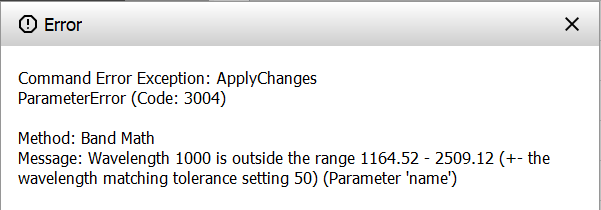Breeze uses the closest match to find data for a wavelength, but a different above the setting for wavelength matching tolerance results in errors when applying the workflow to data.
Wavelength matching in Breeze
Many analyses used in Breeze require data for specific wavelengths. This includes Intensity segmentation or Band math where you specify certain wavelength manually, but also other analyses that use wavelengths implicitly, such as Vegetation index.
Breeze does not require a perfect match for wavelengths. Instead it uses data for the the closest match in the wavelengths used by the measurement or camera to the desired wavelength.
However, if a wavelength does not exist in the data and is too far off, an error is displayed when you apply the workflow:

This prevents performing data analyses that would give wrong results, just because the right data isn’t available.
Before Breeze 2025.1, Breeze always found a match, regardless how far off the desired wavelength the data was, but since this could result in poor results, we changed this behavior.
Wavelength matching tolerance setting
InWorkspace Settings, on the General tab, the setting Spectral wavelength matching tolerance controls how far off a wavelength is allowed to be to be considered a match. Outside the tolerance, an error message is displayed when applying the workflow to data (see above).

In the example that resulted in the above error message screenshot, given the default tolerance value of 50, and if you used Band math and used the formula w1000, it would not match any data since the lowest wavelength is 1164.52, resulting in the error, but if we would change to w1120it would work, because that is within 50.
If you effectively want to disable the requirement that the matching wavelength is close to the target wavelength, change the setting to a large number such as 10000.
Analyses that use wavelength matching
Many different analyses use wavelengths that you either specify manually, such as Intensity segmentation or Band math or where the wavelengths are provided implicitly by Breeze, such as Vegetation index.
